“What we have has cost us a lot of sweat,” said Ariel Velásquez, as an iridescent green hummingbird flitted between the flowers outside his home in search of nectar. “We don’t want mining in our territory.”
A 36-year-old farmer, Velásquez lives at the very edge of Vereda La Soledad, a coffee and plantain farming community in the municipality of Jericó, in southwestern Antioquia, Colombia. His house sits close to the brink of a precipice, where the lush green hills suddenly give way to cliffs, enveloped in mist whenever a cloud rolled past, temporarily obscuring the sweeping view of the Cauca River valley down below.
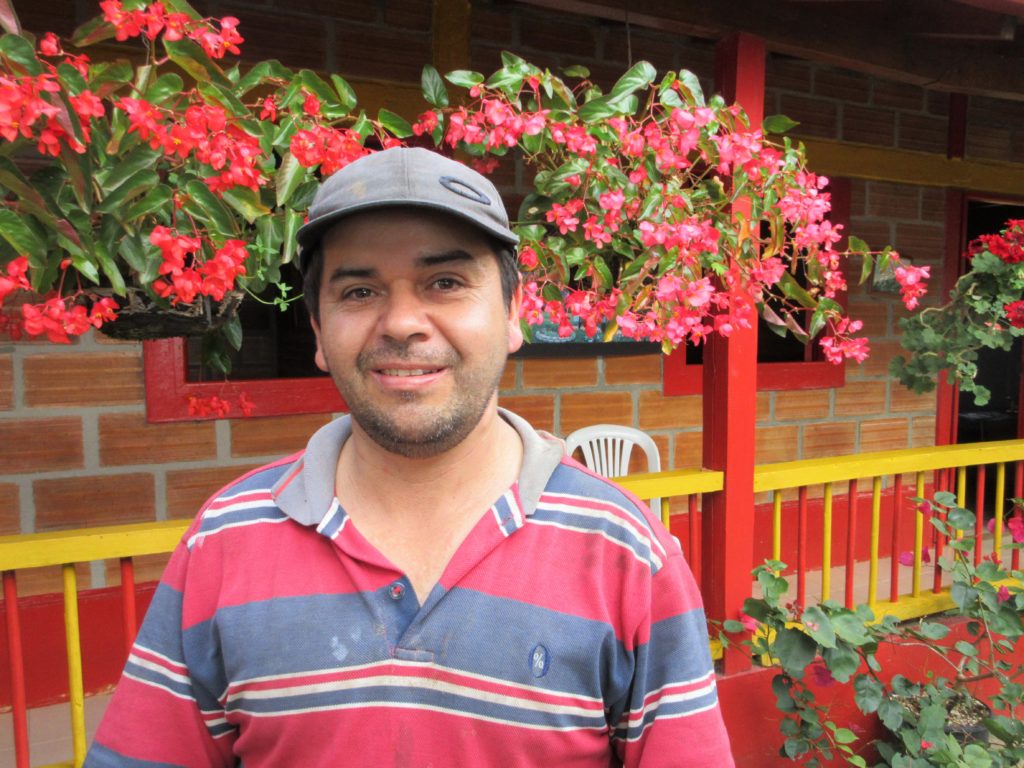
For a decade, residents of La Soledad and nearby communities, including the town of Jericó, have been battling a giant, and that battle could soon heat up. AngloGold Ashanti, one of the world’s biggest gold mining companies, has its sights set on a large-scale underground copper and gold mine in the area. Colombia’s National Environmental Licensing Authority announced in late January it had begun its review of the company’s environmental impact assessment to determine whether or not the mine can proceed.
It takes around an hour by jeep to travel the seven miles along a bumpy road from Jericó to La Soledad, past a metal gate the mining company installed to block access at a turn-off. The short, steep hike down to Velásquez’ property cuts through plots of coffee and plantain, with flashes of color from butterflies and tanagers flying around in the shade. The coffee harvest season was just beginning and the branches were laden with fruit, here and there a deep red, ready for picking. Near the edge of the mountain community, water cascades from the ridge down a steep rock face, a constant reminder to Velásquez and others of what they’re fighting to protect: the water.
“Early on, we were not informed and we didn’t know anything about the mining issue. We thought it meant progress,” Velásquez told Toward Freedom.
Things changed in La Soledad when drilling work during the exploration process affected a water source. “That’s when we realized the company was a very harmful company,” said Velásquez. “Seeing the things they were doing, we took on the struggle to stop them from continuing work here.”
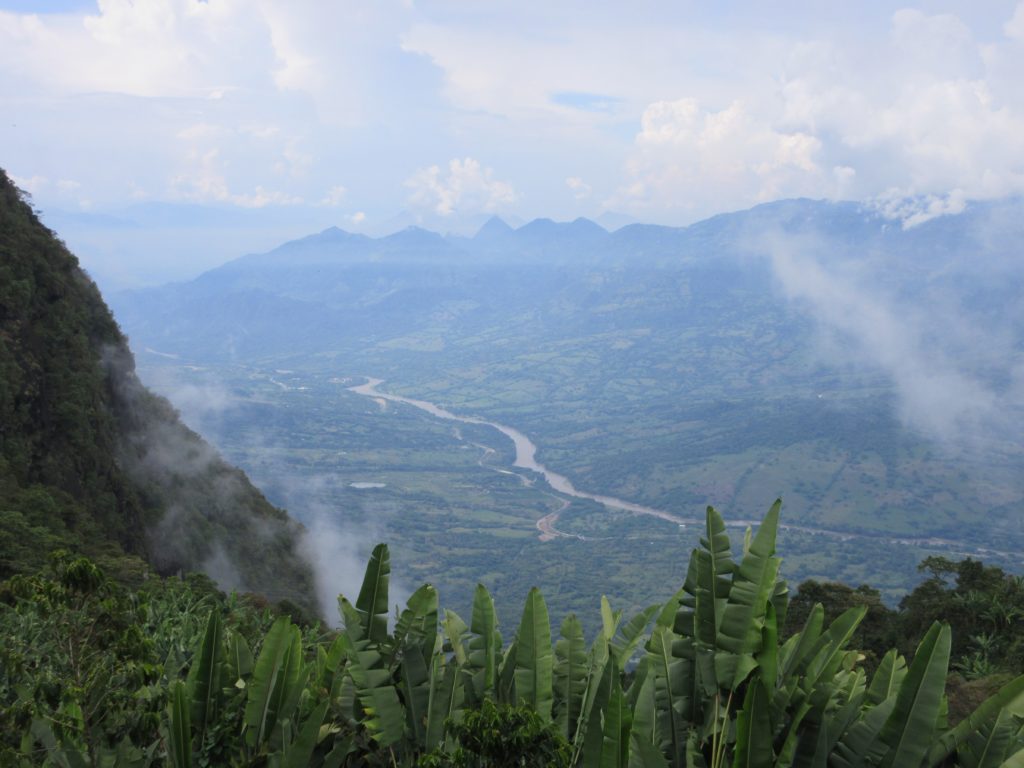
Farmers from the rural area between La Soledad and Palocabildo started protesting a decade ago, blocking the access road off and on for years to prevent AngloGold Ashanti vehicles or personnel from entering to carry out exploration work. Local laborers employed by the company for short-term contracts initially advised their neighbors of the risks mining exploration posed to local water sources, and workers later tipped off farmers when company vehicles were heading to the area.
The copper and gold deposit itself is in lands owned by the company, but access tunnels would come in from below, passing underneath lands and water sources used by mountain farmers. Citrus growers and cattle ranchers in the valley lowlands of Jericó also have concerns about the potential impacts of mining and supported the mountain community farmers with financing for independent studies.
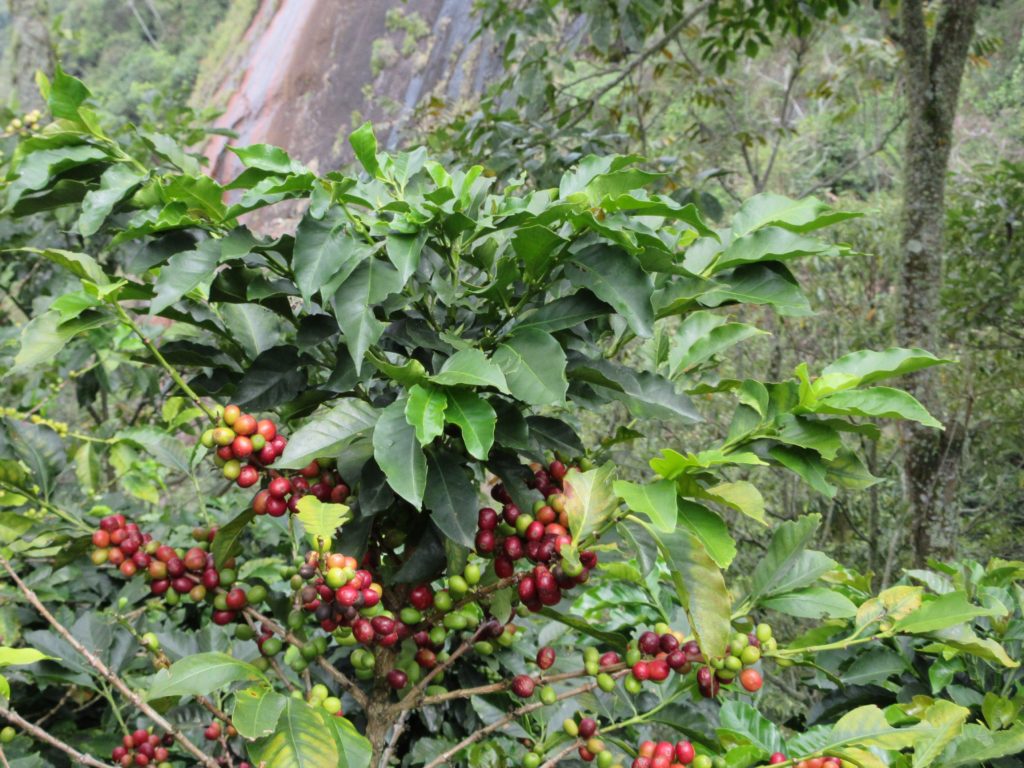
Around the same time the mining resistance movement began, a small contingent of soldiers was stationed in the area. Last year, when farmers were blocking the access road to prevent the company from finishing up studies required for its licensing application, the government sent in ESMAD, the Colombian anti-riot police force with a long record of accusations of excessive force and human rights abuses, along with troops and local police.
“They said the studies were going to happen no matter what,” said Velásquez. “The police came to instill fear and terror, telling us they were going to criminalize us and that they were going to put us in jail, that we were committing a crime and that punishment would be drastic.”
The situation was tense, but there was no violent crackdown nor did the intimidation blunt the resistance. From very early on, farmers have had support from Jericó town residents and beyond. The municipal movement against AngloGold Ashanti is part of a strong regional resistance movement against mining in southwestern Antioquia. Theirs is one of Colombia’s many Indigenous, community and environmental movements defending lands and people against the extractive industries.
AngloGold showed up in Jericó back in 2003, a year before the British company merged with Ashanti Goldfields Corporation of South Africa to form AngloGold Ashanti, based in Johannesburg. After years of prospecting and exploration in the region, the firm narrowed its focus to one deposit for its Quebradona project. According to the company, the deposit, located some 1,300 feet below the surface, contains 2.96 billion pounds of copper and 2.22 million ounces of gold, and the production phase could last 21 years.
It wasn’t until several years after the mining company’s acquisitions in the area that Jericó residents realized what was going on. “When we became aware of it, it was already late,” said Óscar Villa, an energetic retiree involved in organizing efforts against the mine. From a viewpoint above town, he pointed out town landmarks down below and the mountain ridge lands in the distance he and others are fighting to protect.
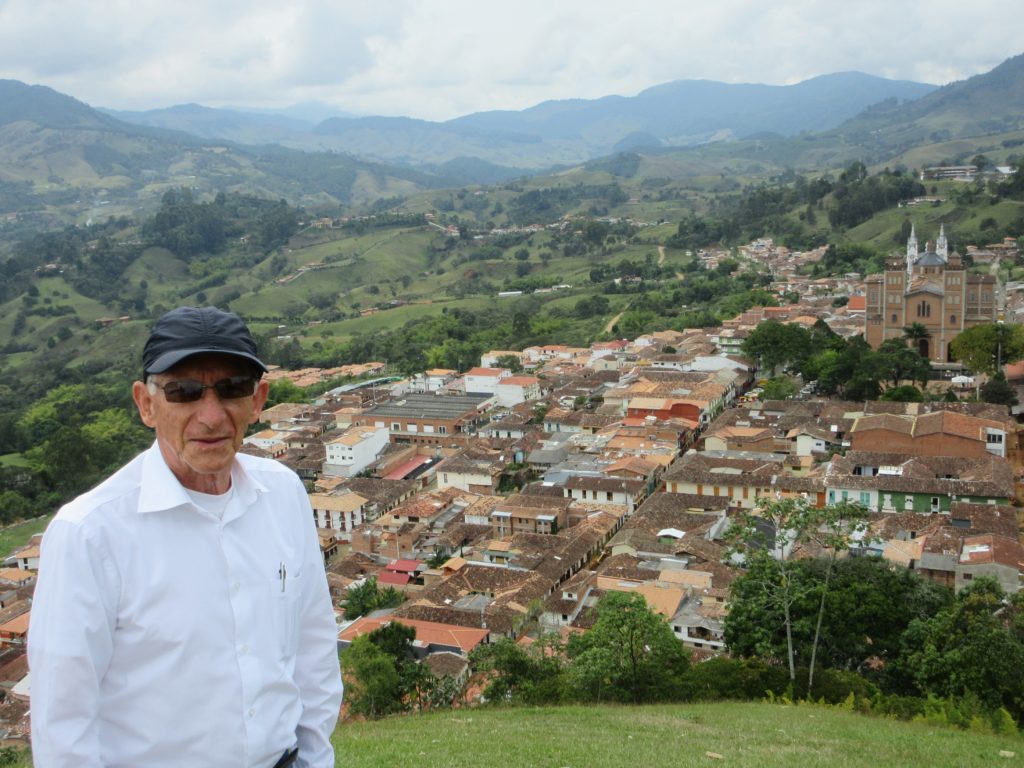
“Avocado and fruit crops are increasing, but traditionally, this has been a coffee-growing municipality. Tourism is also important, and it’s cultural tourism,” Villa told Toward Freedom. Roughly two-thirds of the municipality’s 13,000 residents live in the picturesque town of Jericó, home to museums, a theater, botanical gardens, multiple churches, and nearby hikes.
Jericó is the birthplace of Laura Montoya, also known as Saint Laura of Saint Catherine of Siena, the first and only Colombian saint, canonized in 2013. It’s one of the 17 towns in Colombia the Ministry of Commerce, Industry and Tourism has declared “heritage towns,” and it’s a popular weekend getaway destination for residents of Medellín, just three hours away, while others visit from further afield. The front of nearly every home in Jericó is painted with three varying colors, lining the streets with bright multi-colored window and door trims.
Signs and little flags carrying messages of opposition to mining also adorn some houses in town. Jericó is home to a municipal Mesa Ambiental, an Environmental Roundtable of sorts. Now a grassroots space, the roundtable was created by Antioquia departmental environmental authorities as part of a wider program to foment citizen participation. Antioquia’s Environmental Authority and Jericó’s municipal government were part of it, and so was AngloGold Ashanti. One of the first initiatives of citizen participants was to get the company out of the roundtable, according to Fernando Jaramillo, one of the most active local organizers. The company withdrew, and then gradually government officials did too.
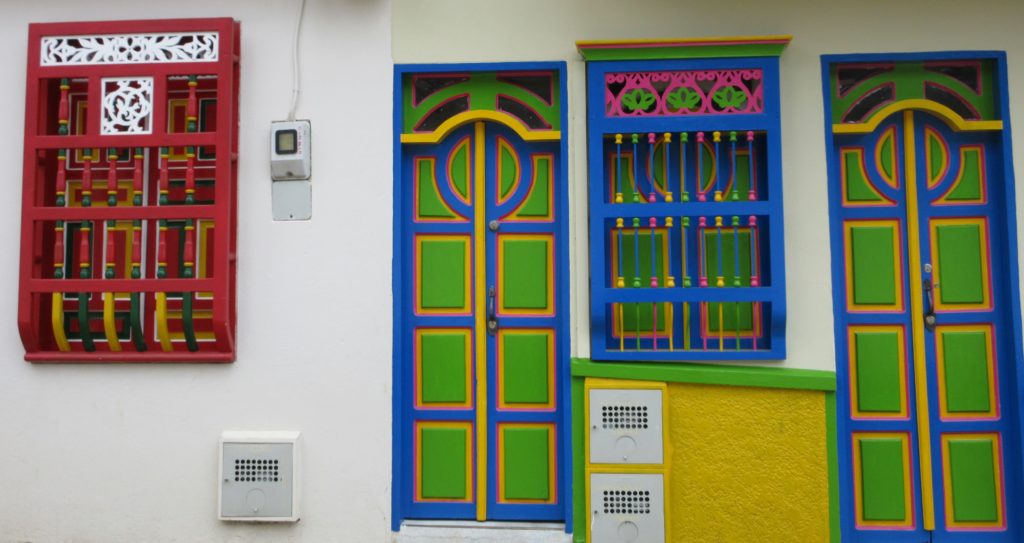
“Now our roundtable is completely autonomous,” Jaramillo told Toward Freedom. Opposition to mining quickly became the focus of the roundtable, in support of farmers from affected communities who had been setting up roadblocks to impede company access. “The mountains where they have been exploring is a mountain of great water wealth. It supplies aqueducts for here in Jericó and [neighboring municipality] Támesis,” he said. “Many rural mountain community aqueducts begin there.”
Residents of Jericó, Támesis and other municipalities in southwestern Antioquia began exploring options to stop mining activity in the region, including the consulta popular, a local referendum. Legislation ranging from municipal codes to international conventions have been used as consultation and referendum mechanisms to demonstrate opposition to large-scale mining projects and decree local bans. This practice was spearheaded in Tambogrande, Peru (2002); Esquel, Argentina (2003); and Sipakapa, Guatemala (2005).
Between 2013 and 2018, ten municipalities in six different departments of Colombia held a referendum on mining, each one resulting in an overwhelming majority of participating voters rejecting mining. But in 2018, the country’s Constitutional Court reversed course from its earlier rulings on the binding nature of the consulta popular and ruled against local referenda on mining and oil projects, arguing the State, not municipalities, owns the subsoil. Then, in February 2019, the Constitutional Court struck down the article of a law that mandated a local referendum be held prior to the commencement of mining, oil, and other projects.
Dozens of municipalities, including Jericó, had mining referendum plans in the works, and they all ground to a halt. “Municipal agreements arose as an alternative in the face of the government decision not to recognize the consultas populares,” said Jaramillo. The movement against mining in southwestern Antioquia turned to another article of the constitution stipulating one of the responsibilities of municipal governments is to dictate the norms necessary for the control, preservation and defense of local ecological and cultural heritage.
The mining resistance movements in Jericó and Támesis proposed the measure to their respective municipal councils, and in 2017 both passed an agreement decreeing a local ban on mining activity. Eleven other municipalities in southwestern Antioquia soon followed suit. But they needed the government of Antioquia to sign off on the decrees, and it declined, referring them instead to the department’s administrative tribunal. The tribunal began suspending and invalidating the municipal mining bans, and local governments appealed the decisions.
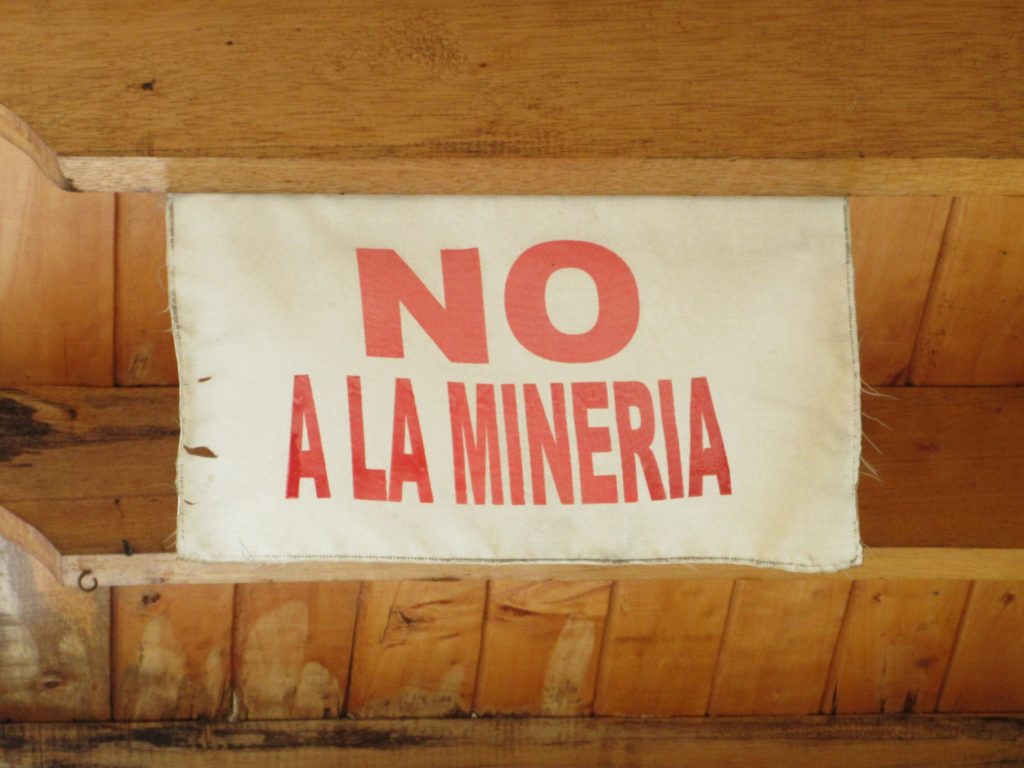
In 2018, the national-level Council of the State affirmed the legality of the municipal agreement banning mining in Urrao, one of the 13 municipalities in southwestern Antioquia that enacted the measure. “Municipalities may prohibit mining [and energy project] activity in their territories in the exercise of their powers regarding environmental protection and land use regulations,” the council ruled. But the decision came out within days of the Constitutional Court ruling establishing the exact opposite.
Jericó’s first mining ban had been invalidated, but in light of the Council of the State’s decision, the municipal council passed another one. The company had voiced concerns over the first decree, but did not abide by the second. “AngloGold Ashanti did not respect the agreement. It continued working. Despite the ban, it continued working,” said Jaramillo.
“Every time they entered with their vehicles into the exploration zone, farmers blocked the vehicles and obligated [company] personnel to leave,” he said. “On two occasions, the municipal administration made the decision to –as a police measure– suspend the activities they were carrying out.” The mayor himself, a former participant in the Environmental Roundtable, personally accompanied police to the area to uphold the local mining ban, ordering company personnel to halt exploration work.
In September 2019, Antioquia’s administrative tribunal suspended Jericó’s second ban, and the Council of the State had already backtracked on the validity of municipal agreements. The mining resistance movement in Jericó has also lost an important ally. A new mayor took office this past January 1, and he’s in favor of the Quebradona project. The mining issue has polarized the town and farming communities. If the National Environmental Licensing Authority gives the mine the green light, the conflict could heat up. But so far, the conflict has not been accompanied by violence.
“Jericó is characterized by peace,” said Jaramillo.
Antioquia has been hard hit by violence over the more than five decades of conflict ostensibly between guerrilla forces and Colombia’s US-funded military. The vast majority of combatants from the Revolutionary Armed Forces of Colombia (FARC), the largest guerrilla force, disarmed following a peace deal in 2016, but the National Liberation Army (ELN) is still active, including in Antioquia. However, roughly 80 percent of conflict victims have been civilians, according to Colombia’s National Center for Historical Memory. And right-wing paramilitary forces, sometimes backed by transnational corporations, have been protagonists of most conflict-related civilian killings around the country.
In Antioquia, paramilitary forces were responsible for the majority of the 756 massacres that killed nearly 4,500 people between 1980 and 2014, according to a study by an observatory comprised of researchers from five Colombian universities. Those 756 massacres in Antioquia, one of Colombia’s 32 departments, represented 29 percent of all massacres in all of Colombia during the same period. Only one was recorded in Jericó, in 2001, when four local farmers were abducted by paramilitaries, executed, and found in Támesis.
Paramilitary and guerrilla forces have at times showed up in Jericó, but Beatriz Franco has always noted how different Jericó is from nearby municipalities, where paramilitary forces put down roots and violence is ongoing. Originally from the neighboring municipality of Andes, Franco’s work in the culture sector took her to municipalities throughout the southwest and other parts of Antioquia. Now retired, she settled in Jericó again two years ago after having lived in the town years prior.
“There is something here that is really interesting. Jericó has not been permeated by paramilitarism or by guerrillas,” Franco told Toward Freedom.
“There’s a characteristic here: there is no great concentration of wealth or deep social division. There is no vast accumulation of land or massive agro-industry,” she said. “The social conformation is very different from other municipalities.”
The comparative lack of stratification that sets Jericó apart from its neighbors links back to its origins, said Franco. Jericó was settled in the mid-1800s by people from Medellín and eastern Antioquia. Its founders brought people to work the land, but also allotted them plots of land.
“People here have a deep sense of belonging,” said Franco. “It’s a town that has been culturally distinct from the others. You find more culture here, more education. It’s why they call Jericó the ‘Athens of the southwest.’”
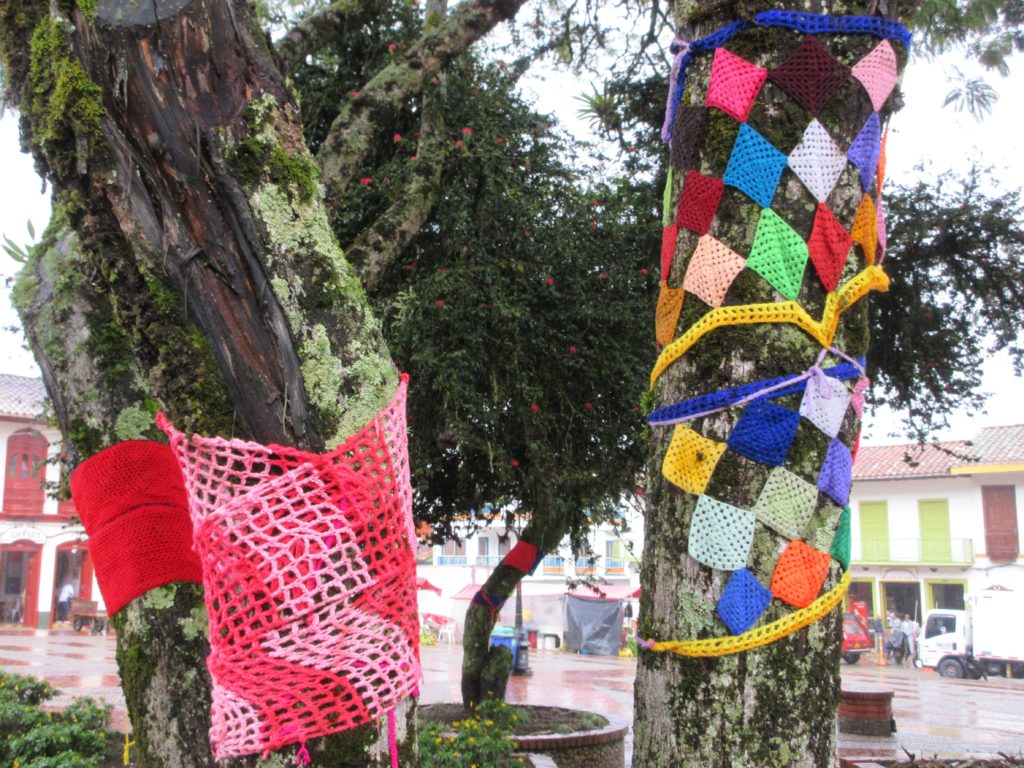
The mining issue, however, has divided the town. Last year, Franco and three other local women planned a different kind of protest action to try to bring people together. They took their inspiration from an action in Popayán, over 300 miles away, where women hung crocheted, woven, and knitted work in a plaza to reclaim a public space lacking in safety for women. In Jericó, the group decided to organize something similar, but with a message of environmental protection.
“No two weavings are alike just like two ways of thinking are not alike, but we do have a common objective, which is the conservation of the environment and defense of the territory,” said Franco.
In the end, 58 women and two men contributed crocheted, knitted and woven pieces, stitched together to loosely hug trees and hang between them in Jericó’s town square. The installation was in place from September to November, and included pieces sent from Popayán with hearts in honor of women survivors of violence. When the pieces were installed, people gathered to recognize local women artisans, women survivors of violence, and social movement leaders who have been murdered in Colombia in recent years.
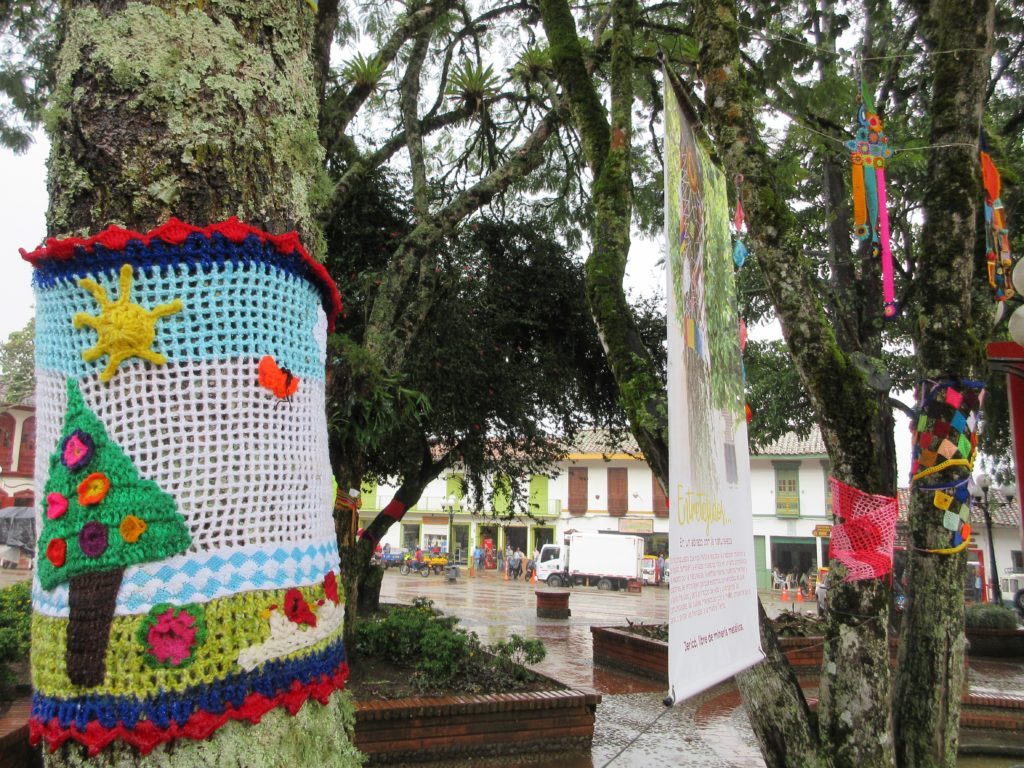
More than 500 Colombian community, Indigenous, social movement and human rights leaders and activists have been murdered over the past four years. In the first two months of 2020, than 50 social leaders and human rights defenders, including seven in Antioquia, according to the Institute for Development and Peace Studies. In Karmata Rúa, an Indigenous Embera Chamí reservation 23 miles southwest of Jericó, two locals have been murdered over the past year and a half and flyers signed by a paramilitary group have been circulated with death threats to community leaders.
Threats and attacks against extractive and energy project opponents are alarmingly common, but not in Jericó. The mining resistance movement has been able to organize and take action without death threats or much fear of violence. No one even defaced the banner stating clear opposition to mining that hung in the plaza along with the women’s art, Franco pointed out.
“No one did anything to destroy it,” she said. “Amid the difference here, there is respect, and that says a lot about the community.”
Some Environmental Roundtable members voiced concerns that the absence of violence may not last if the mine gets the green light for production. But for now, the Quebradona project has generated a deep polarization, both in Jericó itself and in farming communities such as La Soledad, only four miles from town as the hummingbird flies.
“Division. That is what the mining company has brought: division,” said Velásquez. “Now we no longer live in unity. There are people who see us as enemies because we are going out to protest and defend our territory.”
AngloGold Ashanti did not respond by time of publication to Toward Freedom’s request for comment on divisions, water source impacts, and lack of compliance with Jericó’s second municipal agreement. Company materials highlight the Quebradona project’s potential to generate social, environmental and economic progress. ProJericó, a company-created foundation for local health, education, environmental and other projects, will be funded with close to 2.5 million dollars per year once construction starts, according to the company.
But the arrival and presence of AngoGold Ashanti has pitted community residents against each other from the start and even divided families, Velásquez told Toward Freedom under a little gazebo outside his home, overlooking the Cauca River. A pandemonium of parrots flew past, their raucous squawking ringing out over the valley down below.
Velásquez knows it will be harder to blockade the mining company if the Colombian government issues a license for exploitation, especially now without the support of the mayor. But that is not going to stop the farmers. “We will continue to oppose them,” he said. “They are not going to make us change our minds.”
Author Bio:
Sandra Cuffe is a freelance journalist reporting on politics, social movements and human rights in Central America and beyond. You can find her on Twitter at @sandra_cuffe or read more of her work at sandracuffe.com.
